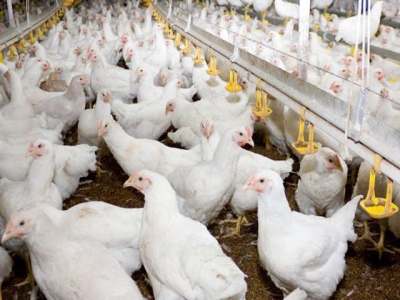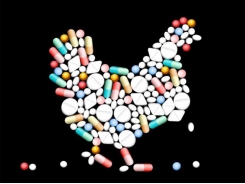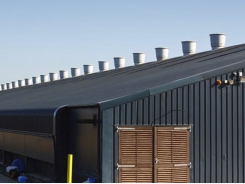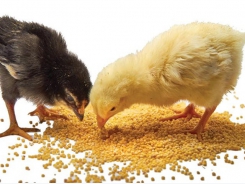Understanding salmonella entryways in poultry may improve interventions

Aerosolization found to also be important route for salmonella colonization and potential spread throughout a poultry house.
The U.S. Poultry & Egg Assn. (USPOULTRY) and the USPOULTRY Foundation announced the completion of a funded research project at Auburn University in Alabama in which researchers were able to provide insight on colonization of broilers by salmonella.
In the study, Dr. Ken Macklin and Sarge Bilgili from Auburn studied the ability of Salmonella enteritidis (SE) and Salmonella heidelberg (SH) to colonize and persist in various tissues and organs of broilers inoculated by various routes and at different ages, USPOULTRY said.
In an industry summary, Macklin and Bilgili explained that ensuring the safety of poultry products is a high priority to producers, consumers and regulatory officials.
Broiler carcass contamination at the processing plant is difficult to avoid if chickens arrive at the processing plant contaminated with salmonella, they said.
According to Macklin and Bilgili, during rearing and processing of broilers, there are a variety of potential sources for salmonella contamination, and several preventative strategies have been implemented with varying degrees of success. However, they added that an understanding of the different potential entryways and resulting colonization sites needs further analysis so effective control strategies can be developed.
Macklin and Bilgili said the first objective of this project was to determine if SE and SH can cause a systemic infection when administered to broilers by various routes.
In the first trial, broilers were provided with feed contaminated by salmonella at a dose of 102 colony-forming units (CFU) per gram continuously starting at day 0 and lasting throughout the growout (day 35).
In a second study, broilers were given feed contaminated at a higher level (104 CFU/g) from 14 to 18 days of age. In addition, five different inoculation routes (cloacal, ocular, oral gavage, intratracheal and subcutaneous injection) at 104 CFU per dose on days 0 and 14 were utilized to determine salmonella colonization, the researchers noted.
The second objective was to determine the tissues that were colonized by these inoculation routes. The samples that were tested were the cloaca, trachea, lung, ceca, kidney, intra-abdominal cavity, skin, breast meat, thigh meat, crop, spinal cord, bone marrow, plus two pooled samples (liver/spleen and thymus/bursa), Macklin and Bilgili reported, noting that these routes were selected to mimic potential real-world points of entry into the bird at the hatchery, during chick transport and at the farm.
According to Macklin and Bilgili, the continuous exposure of birds to a low level of either SE or SH in the feed from day 0 until trial termination (day 35) resulted in every bird having at least one positive sample.
The second feed trial, in which birds were fed contaminated feed at a higher dose of SE or SH during days 14-18, produced lower overall levels of salmonella contamination, the researchers said. However, SE was isolated from more than 50% of the exposed birds, while SH was isolated from only 2% of the exposed broilers, which was likely due to the inability of SH to survive for a long period of time on feed, Macklin and Bilgili said.
In birds inoculated by various routes at day 0, the intratracheal, ocular and oral routes gave the highest recovery of salmonella among the collected samples, while the subcutaneous route resulted in the lowest recovery, the researchers added.
They pointed out that all inoculations at 104 CFU resulted in some recovery from multiple organ and tissue samples when administered at day 0. In the birds that were inoculated at day 14, the groups inoculated by the ocular, intratracheal and cloacal routes had the greatest incidence of salmonella recovery at day 35, the researchers said.
These results show that introduction of SE or SH can occur at any point during the life of the flock, Macklin and Bilgili said.
As an enteric pathogen, the fecal/oral route has been the most commonly investigated route of inoculation. Maklin and Bilgili said their research supports that route as being an important one; however, it also shows that aerosolization (intratracheal) is also an important route for salmonella colonization and potential spread throughout a poultry house.
Macklin and Bilgili further concluded that the cecum is the best organ for salmonella isolation but noted that salmonella has the potential to be found in any organ.
These experiments showed that salmonella isolates vary in their ability to survive outside the host. The SE isolate used in these studies was recoverable four days after being inoculated onto feed, while the SH isolate was recoverable for only two days.
This could be an important factor in determining the ability of a salmonella isolate to spread through a poultry complex by means of contaminated feed, the researchers said.
Related news
Tools

Phối trộn thức ăn chăn nuôi

Pha dung dịch thủy canh

Định mức cho tôm ăn

Phối trộn phân bón NPK

Xác định tỷ lệ tôm sống

Chuyển đổi đơn vị phân bón

Xác định công suất sục khí

Chuyển đổi đơn vị tôm

Tính diện tích nhà kính

Tính thể tích ao




 Antimicrobial resistance intensifies in low-, middle-income countries
Antimicrobial resistance intensifies in low-, middle-income countries  Is inflammation control key to antibiotic-free poultry?
Is inflammation control key to antibiotic-free poultry?